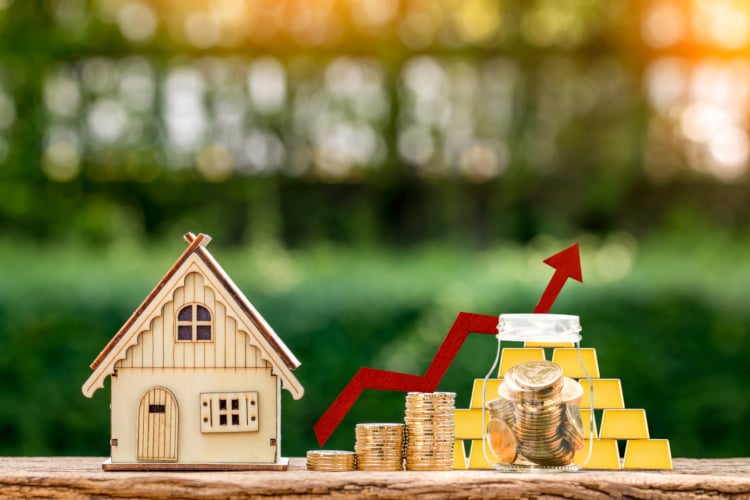UNLOCKING THE VALUE OF SFR INVESTMENTS
When it comes to investing in single-family real estate (SFR), the best investors are focused, disciplined and strategic. In this article, we’ll explore the merits of two different investment strategies:
- Strategy 1: Fix and Flip (buy, rehab, sell)
- Strategy 2. Fix and Hold (buy, rehab, rent)
On the surface, these investment strategies seem quite simple, almost colloquial to the conversations held at almost every cocktail party or backyard BBQ. Who doesn’t have a friend or family member who told them the story of a house they bought low, sold high, and took the profit to the bank?
By that same token, with the maturity of the SFR asset class over the past decade, who hasn’t heard of the BRRR method—the Rich-Dad-Poor-Dad approach to wealth creation via real estate? Or, knows someone in their circle with a small portfolio of rental houses that provides passive income on the side. The investment in housing as a side hustle or full-time profession seems almost as old as the American Dream of home ownership.
But investing in single-family real estate is not as easy as the newest HGTV show would have you believe. As stated earlier, it requires focus, discipline, and strategy. And the best SFR investors combine the art of the flip with the science of the rental as they walk toward the finish line of wealth creation. If all we have is time and money, let’s explore how we can best utilize both for ultimate success in this game, otherwise known as single-family rental investments.
Fix and Flip
The Benefits
- Profit Potential – That’s the name of the game. Fast Money. Buy Low. Sell High. There is usually more upfront rehab work involved in this cash-intensive business, but the hold periods are typically 6 to 9 months for seasoned SFR investors, and that spells money in the bank this year – near term.
- Market Knowledge – They say knowledge is power and nowhere is that more true than when it comes to SFR investing. You know the market and are involved in it. You have a deal under contract. You have closed a deal and are rehabbing the property with “profit potential” spelled all over it. You know the purchase price accepted by the Seller. You know the recent sales comps that support your potential profit. You know the cost of materials. You know the Buyers and what they are offering you, whether they are end-users or SFR investors looking for a rental property. Knowing the market is almost as good as money in the bank. Referral Opportunities – Akin to market knowledge, nothing beats a recent close, a house under renovation on a gentrifying street, or a recently closed deal in a neighborhood with other potential flips. Success breeds success and referral opportunities are a natural fallout to the hard work associated with every fix and flip investment.
The Risks
- The Repair Budget – If time is money, it is imperative for the fix and flip investor to have an air-tight repair budget that does not exceed 35% of the total cost of the fix and flip investment. When a rehab becomes a renovation, the profit potential of your investment is at high risk of being lost forever. This risk needs to be considered on the front-end, as you walk the house before making an offer, and hard-wired into your DNA as an SFR investor. Low to moderate repairs on every deal you take on as an SFR investor is the key to remaining entrepreneurial and profitable.
- Cash Intensive Game – Just as knowledge is power, so is cash king. And if cash is king, then tending to your cash balances as an SFR investor is just as important as knowing your market, watching your budget, and jumping on that next referral opportunity. The cash intensive nature of the SFR investor has made many seasoned pros—with millions of dollars in the bank—feel like paupers after allocating those millions into multiple SFR investments that haven’t sold according to plan. Rule of thumb: Don’t become so overextended that you can’t think straight during the investment cycle. Keep enough cash reserves in the bank to feed the family and finance all outstanding SFR rehab costs so that you maintain a sound mind at all times.
- The Great Unknown(s) – No matter how much thought and preparation went into your investment proforma, the likelihood that everything will go “according to proforma” is low. Sure, you may knock it out of the park or “kill it on that deal” as my millennial SFR investors like to say, but odds are, you’ll average fair-to-midland versus somewhere-over-the-rainbow. As a savvy SFR investor, always keep your eye on the “exit” ball and don’t fall prone to some of the great unknown(s). If you see an exit and it’s close to proforma – take it – and move onto the next deal while burning these potential unknowns into your investor hard drive.
- Love for the Deal – do not fall in love with your investment. It’s an investment. Holding out for the top dollar associated with your favorite deal will lead to a tragic outcome every time.
- Market Dynamics – While SFR investing is not as volatile as investing in the stock market per se, there are still market dynamics at work in each neighborhood that you are in (microeconomics) as well as dynamics associated with the greater capital markets (macroeconomics). Keep your finger on the investment pulse of these dynamics so that you can react in the event the winds change.
- End User Tastes – A smart SFR investor might use the tried-and-true trick of neutrals to keep the end user happy on the sale of the house. An even smarter SFR investor might reserve some money in the budget for end user allowances. And an even smarter SFR investor might modestly drop the price to overcome any end user tastes issues that are preventing a quick close.

Buy and Hold
The Benefits
- Cash Flow – Using the cash flow generated by a paying tenant to pay down the mortgage balance on an SFR investment is the wind at your wealth creation back. Even better, using any available net profit after debt service to further pay down the mortgage or provide your business with extra income. The cash flow of a SFR buy and hold investment may not be the same as the “cash flood” profit potential of fix and flip investment, but it provides a slow and steady lift on the SFR investor’s path to wealth creation. This is why it is important to remain disciplined on each buying opportunity. If there is cash flow after vacancy reserves, general & administrative costs, repairs & maintenance, property taxes, and debt service, the cash flow benefit is in your favor.
- Market Knowledge – We said it before, and we’ll say it again: knowledge is power, and nowhere is that more true than when it comes to SFR investing. Landlords talk. Tenants talk. Neighbors and neighborhoods talk. Being in the market as an SFR landlord provides you with the pulse of your market, whether that means knowing what concessions to offer, what rents to charge, what repairs are yours, what repairs are your tenants, etc.
- Referral Opportunities – Just like the fix and flip investment referrals you receive while improving a street or neighborhood, as a SFR landlord, you will receive referrals from tenants’ friends, attentive neighbors that need to sell, or other landlords in your market that need liquidity. Referral opportunities are ever present for the SFR investor/landlord.
- Mark-to-Market Wealth Creation – The stock market can go up and down leaving the investor to wonder or frantically worry about whether they made a sound investment. With the SFR investment, the markets are not so erratic, and the fundamentals can be strong especially if you know your market. There are two ways the SFR investor can benefit from this “mark-to-market” benefit:
- Forced Appreciation – this benefit occurs when a savvy landlord proactively increases the cash flow of a property by raising rent to reflect the market, identifying additional opportunities for generating income or managing property operating expenses.
- Natural Appreciation – this benefit occurs naturally as the value of property rises over time given supply/demand equation for affordable homes, the gentrification of neighborhoods, the growth of a market, etc. This concept of marking the SFR asset to market is an incremental step the investor can take each year as the wealth associated with each investment moves steadily up and to the right.
- Forced Appreciation – this benefit occurs when a savvy landlord proactively increases the cash flow of a property by raising rent to reflect the market, identifying additional opportunities for generating income or managing property operating expenses.
The Risks
- Death By 1,000 Cuts – Property damage. Wear and tear. Leaky sinks. Frayed electrical lines. Chipped paint. Obsolete equipment. Deferred maintenance. Capex expenditures. Tenant move-out expenses. Marketing expenses. Re-leasing expenses. Tenant move-in expenses. Winter, Spring, Summer or Fall – the list is never ending. You can do-it-yourself or hire a third-party manager. Either way, you need to allocate in the necessary budget to cover all the above— and more—for each SFR investment before you experience death by 1,000 cuts.
- The Great Unknown(s) – The fix and flip investment has them and so does the fix and hold investment. No better – just different. Why did my taxes go up? Why is the tenant moving out? The tenant did what? The insurance doesn’t cover it? The HVAC is out again? The heater was fixed last winter! Once again, allocating the appropriate budget to cover all of the above and more for each SFR investment is critical to your success as an SFR investor.
- Force Majeure – Look no further than the recent havoc caused by Hurricane Ian in the Tampa, Florida region and across the State of Florida. There will be events that occur that are unforeseeable, external to any effort the landlord might take to be a prudent and sound manager, and serious enough that it renders your property from being occupied. Property insurance with a sound carrier that covers you with belt and suspenders when these kinds of events occur is critical.

Putting It All Together. The SFR Two-Step.
Fix-and-flips are a great investment strategy that offer a fast return on your investment. However, they require more capital upfront and time. A lot goes into the process and you also have to be able pay for the renovations to happen. However, your money isn’t tied up long-term and are often fluid investments because of the quick turnaround time.
Now that we know the benefits and risks of each SFR investment, how do we put together a winning strategy for wealth creation?
Step 1.
It starts where we began: focus, discipline, and strategy. Most every “complete” SFR investor started as fix and flip investor.
What was their focus?
- Their Market – The Golden Rule of real estate investment has and always will be location, location, location. There is no substitute for knowing your market cold, knowing the opportunities in your market like the back of your hand, and knowing the “tells” that lead to future market opportunities.
- Their Product – Inside my market, what is my focus? Am I chasing the lowest end, the middle of the road, or the high end? Am I looking for 2 BR, 2 BTH rehab or a 3 BR, 2.5 BTH rehab? Am I comfortable with townhomes, condos, or duplexes? What is my product focus?
What was their discipline?
- House Calls – When the phone rings, the SFR investor is in their car driving to the house, meeting the Seller in person, and making a connection with every buy call. They do not send offer letters via email or text. This is hand-to-hand combat, and it is lost and won in the trenches. Make the house call.
- Pricing – Great SFR investors will not stretch beyond their breaking point (read: They do not sacrifice their profit margins for the Seller). The Seller may want a higher number than you are willing to offer. Stick to your guns and be ready to walk away from apparent opportunity if your profit margins are being diminished by concessions to the Seller. There will be another deal down the road if this one doesn’t make.
What was their strategy?
- Wholesale Seller – Seasoned SFR investors know their core competency. If they are wholesale sellers, then they know how to make money on the buy. And, they have identified potential wholesale buyers before closing. Once they have closed, they will typically already have offers in hand to sell the property for a handsome profit as they move onto the next deal even if the rehab improvements are not done.
- Retail Seller – If the SFR investors core competency is rehab expertise, then they will likely carry through with the improvements and take the property to a retail / on-market sale. However, as mentioned previously, the seasoned SFR investor will take top dollar if it comes quickly, and they will take a reasonable haircut if it comes quickly. Pigs get fat. Hogs get slaughtered.
Step 2.
As the SFR investor begins to master the art of the fix and flip, the question of the buy and hold begins to weigh on their mind. It usually comes in the form of the following thought process at the beginning of another year:
“I did really well last year. I hit all my goals and made a lot of money. But I have to start back over this year and do it all over again. How can I supplement my fix and flip income this year with some form of wealth creation? This year, I think I will hold every 5th SFR fix and flip investment and begin to build a SFR portfolio.”
And the wealth creation journey begins. From this point forward, the two-step process of investing in SFR fix and flip opportunities and SFR fix and hold opportunities will transform the balance sheet of the SFR investor just as the SFR investor transforms the neighborhoods where they make their market. Holding every 5th property will lead to holding every 3rd property to holding every other property. Small SFR portfolio transactions will present themselves; large SFR portfolio transactions will present themselves. And along the way, the focus, discipline, and strategy of the successful SFR investor will remain as sharp and intact as it was on their very first SFR acquisition.

The Numbers Don’t Lie.
Most active SFR investors of the past decade have experienced year-over-year growth in the market. For some, it may be low-single to high-single digit growth. For others, it has been low-double to high-double digit growth. Regardless, the SFR investor whether buying, holding, or both has benefitted from the growth. As you consider the SFR Two-Step, take a look at the comparison below and think about how you might benefit from a combined buy and flip / buy and hold approach going forward.
See a deep dive comparison of a fix-and-flip property compared to a buy-and-hold over 3 years.
SFR Two-Step Financing
With Residential Capital Partners, you get more than a lender…you get a partner to help you make good on every SFR investment.
| Buy and Hold | Buy and Rent | |
| Product | SFR 1 to 4 | SFR 1 to 4 |
| Other | Townhomes/ Condominiums |
Townhomes/ Condominiums |
| Loan Amount | $100,000 to $1,250,000 | $100,000 to $5,000,000 |
| LTV | Up to 70% ARV |
Up to 75% Cash-Out Up to 80% Rate & Term |
| Interest Rate | 11% | Starting at 7% |
| Appraisal & Processing | $700 | $700 |
| Document Preparation | $1,000 | $1,495 |
| Origination | 3 points | 3 points |
| Term | 9 months | 5/1, 7/1, 30-year |
| Prepayment | None | Penalties may apply |




